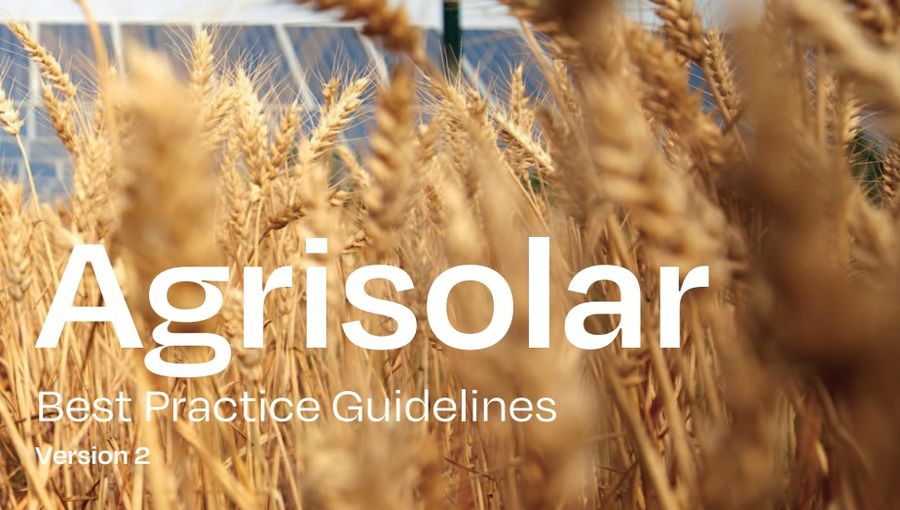The “Agrisolar Best Practice Guidelines Version 2.0” by SolarPower Europe, published in June 2023, provides a comprehensive framework for integrating solar photovoltaic (PV) systems with agricultural practices, known as agrivoltaics or AgriPV. This report addresses the rapid expansion of the agrisolar sector amidst global challenges such as climate change, energy crises, biodiversity loss, and food and water insecurity. Below is a detailed summary of the key points, themes, and case studies presented in the document, based on the provided excerpts.
### Context and Importance of Agrivoltaics
The report highlights the critical global challenges driving the need for agrivoltaics. The Intergovernmental Panel on Climate Change (IPCC) 6th Assessment Report (March 2023) notes that human-induced global warming has increased global surface temperatures by 1.1°C above pre-industrial levels, with greenhouse gas emissions continuing to accelerate climate change. This warming contributes to biodiversity loss, food insecurity, and an impending water crisis. Concurrently, events like the COVID-19 pandemic and Russia’s invasion of Ukraine have exacerbated energy crises, underscoring the urgency for sustainable energy solutions like agrivoltaics.
Agrisolar combines solar energy production with agriculture, optimizing land use by allowing simultaneous crop cultivation or livestock grazing and solar power generation. This dual-use approach addresses land competition, enhances energy security, reduces farmers’ energy costs, and promotes sustainable agricultural practices. The report emphasizes agrivoltaics’ potential to mitigate climate change, improve soil health, and support biodiversity while maintaining or enhancing agricultural productivity.
### Key Themes and Objectives
1. **Sustainability and Land Use Efficiency**: Agrivoltaics enables the coexistence of solar energy production and agriculture, reducing land use conflicts. By integrating PV systems with farming, it supports sustainable land management and contributes to carbon capture, biodiversity preservation, and desertification prevention.
2. **Economic Benefits for Farmers**: The report underscores significant cost-saving potential for farmers. For instance, solar-powered irrigation systems, like those developed by Solaqu, can reduce energy costs by up to 70%, addressing the issue of energy bills constituting up to 50% of farmers’ production costs in Europe, which have risen twelvefold over the past decade.
3. **Technological Innovation**: The document highlights innovative technologies enhancing agrivoltaic systems, such as smart sensors for pollinators, advanced irrigation systems, and digital platforms for land and livestock management. These innovations improve farm efficiency, reduce environmental impacts, and enhance agricultural output.
4. **Policy and Collaboration**: The report acknowledges the contributions of SolarPower Europe’s Land Use and Permitting Workstream and its sponsor members, emphasizing the importance of collaboration between industry, policymakers, and researchers to develop best practices and scalable solutions.
### Case Studies and Examples
The report includes several case studies and examples illustrating the practical application of agrivoltaics across Europe, showcasing diverse approaches and their benefits:
1. **Hyperfarm AgriPV Demonstration Facility (Shasinkchien, Bavaria, Germany)**:
– **Institution**: Fraunhofer Institute for Solar Energy Systems (ISE).
– **Crops**: Potatoes, wheat, barley, and cabbage.
– **Description**: This project demonstrates the feasibility of combining solar PV systems with traditional crop cultivation, optimizing land use and energy production.
2. **Dynamic AgriPV on Fruit Farming (Auvergne-Rhône-Alpes, France)**:
– **Organizations**: Sunugrn and Setra.
– **Description**: Focuses on integrating dynamic PV systems with fruit farming, allowing adjustable solar panels to balance sunlight for crops and energy generation.
3. **Vertical Fieldcrop PV (Auvergne Region, France)**:
– **Organization**: Engig.
– **Crops and Practices**: Various crops combined with animal husbandry.
– **Description**: Utilizes vertical PV systems to minimize land footprint while supporting crop growth and livestock grazing, enhancing biodiversity and land efficiency.
4. **Symbolizon Project (AImare, Netherlands)**:
– **Organization**: Vattenfall.
– **Description**: Features ecological strips integrated with digital PV modules, promoting biodiversity and sustainable land management alongside energy production.
5. **Wiesacolar and Conorive Programme**:
– **Organization**: Bocod.
– **Description**: Focuses on innovative agrivoltaic tracking systems to optimize solar panel positioning for both energy generation and crop growth.
6. **Smart Sensors for Pollinators (3Bie)**:
– **Description**: Developed by Sic Technologies in collaboration with the European Space Agency, this project uses satellite-based solutions (e.g., Flora) to monitor and support pollinator populations, addressing biodiversity loss in agrivoltaic systems.
7. **Solaqu Irrigation Systems (Alicante, Spain)**:
– **Description**: Provides solar-powered irrigation systems that operate independently of the grid, reducing energy costs by up to 70%. These systems eliminate upfront costs for farmers through an energy-as-a-service model, ensure high-quality installations, and prevent issues like water hammers and equipment depreciation.
8. **Animob Mafra (Agritech Startup)**:
– **Description**: A pre-seed startup developing a digital “matchmaking” platform to connect livestock farmers with landowners for regenerative land management. This service facilitates grazing to control biofuels, improve soil health, and reduce environmental impacts, contributing to carbon capture and biodiversity preservation.
### Technological and Agritech Innovations
The report details several agritech innovations that enhance agrivoltaic systems:
– **Smart Sensors for Pollinators**: Technologies like Flora use satellite data to monitor pollinator habitats, supporting biodiversity conservation.
– **Atnoccooling**: Boosts farm efficiency by optimizing cooling systems for agrivoltaic installations.
– **Solaqu’s Solar Irrigation**: Offers grid-independent, cost-effective irrigation solutions with advanced quality assurance and performance surveillance.
– **Animob’s Digital Platform**: Integrates livestock and land management to improve soil quality, reduce farm costs, and enhance meat quality through regenerative practices.
### Challenges and Future Outlook
The report acknowledges challenges such as the high upfront costs of agrivoltaic systems, which innovations like Solaqu’s energy-as-a-service model aim to address. It also emphasizes the need for continued research, policy support, and stakeholder collaboration to scale agrivoltaics globally. The European solar sector is positioned as a leader in this transition, with agrivoltaics offering a pathway to address energy, food, and environmental crises simultaneously.
### Conclusion
The “Agrisolar Best Practice Guidelines Version 2.0” underscores the transformative potential of agrivoltaics in addressing global challenges. By integrating solar energy with agriculture, agrivoltaics promotes sustainable land use, reduces energy costs, supports biodiversity, and enhances food security. Through case studies, technological innovations, and collaborative efforts, the report provides a roadmap for stakeholders to implement and scale agrivoltaic systems, positioning Europe as a leader in the global energy transition.
For further details or to access the full report, contact SolarPower Europe at info@solarpowereurope.org or visit their website, as cited in the document.

